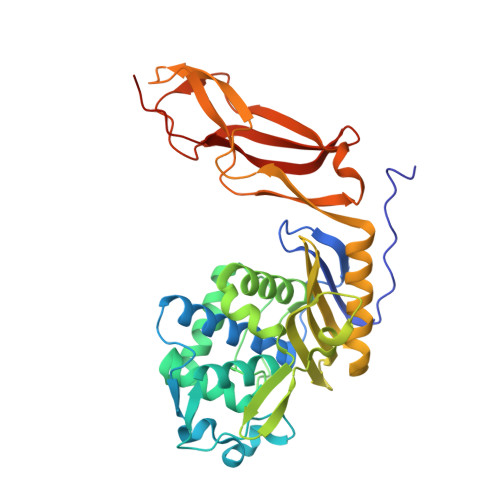Crystal structures of covalent complexes of beta-lactam antibiotics with Escherichia coli penicillin-binding protein 5: toward an understanding of antibiotic specificity
Nicola, G., Tomberg, J., Pratt, R.F., Nicholas, R.A., Davies, C.(2010) Biochemistry 49: 8094-8104
- PubMed: 20726582
- DOI: https://doi.org/10.1021/bi100879m
- Primary Citation of Related Structures:
3MZD, 3MZE, 3MZF - PubMed Abstract:
Penicillin-binding proteins (PBPs) are the molecular targets for the widely used β-lactam class of antibiotics, but how these compounds act at the molecular level is not fully understood. We have determined crystal structures of Escherichia coli PBP 5 as covalent complexes with imipenem, cloxacillin, and cefoxitin. These antibiotics exhibit very different second-order rates of acylation for the enzyme. In all three structures, there is excellent electron density for the central portion of the β-lactam, but weak or absent density for the R1 or R2 side chains. Areas of contact between the antibiotics and PBP 5 do not correlate with the rates of acylation. The same is true for conformational changes, because although a shift of a loop leading to an electrostatic interaction between Arg248 and the β-lactam carboxylate, which occurs completely with cefoxitin and partially with imipenem and is absent with cloxacillin, is consistent with the different rates of acylation, mutagenesis of Arg248 decreased the level of cefoxitin acylation only 2-fold. Together, these data suggest that structures of postcovalent complexes of PBP 5 are unlikely to be useful vehicles for the design of new covalent inhibitors of PBPs. Finally, superimposition of the imipenem-acylated complex with PBP 5 in complex with a boronic acid peptidomimetic shows that the position corresponding to the hydrolytic water molecule is occluded by the ring nitrogen of the β-lactam. Because the ring nitrogen occupies a similar position in all three complexes, this supports the hypothesis that deacylation is blocked by the continued presence of the leaving group after opening of the β-lactam ring.
- Department of Biochemistry, Medical University of South Carolina, Charleston, South Carolina 29425, USA.
Organizational Affiliation:


















